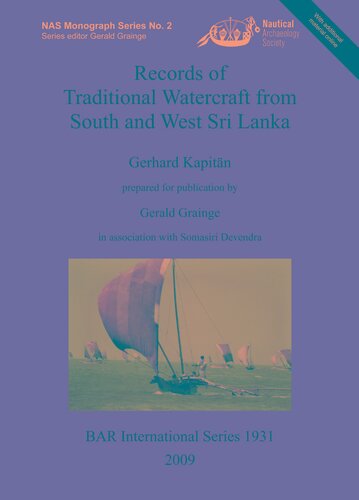

Most ebook files are in PDF format, so you can easily read them using various software such as Foxit Reader or directly on the Google Chrome browser.
Some ebook files are released by publishers in other formats such as .awz, .mobi, .epub, .fb2, etc. You may need to install specific software to read these formats on mobile/PC, such as Calibre.
Please read the tutorial at this link: https://ebookbell.com/faq
We offer FREE conversion to the popular formats you request; however, this may take some time. Therefore, right after payment, please email us, and we will try to provide the service as quickly as possible.
For some exceptional file formats or broken links (if any), please refrain from opening any disputes. Instead, email us first, and we will try to assist within a maximum of 6 hours.
EbookBell Team

0.0
0 reviewsNAS Monograph Series No.2
Gerhard Kapitän, born in Meissen (Dresden, Germany) on the 23rd April 1924, is a scholar whose main field of study is maritime archaeology and ethnography. This book is Gerhard Kapitän's inventory of traditional Sri Lankan watercraft and his great achievement. Prepared for publication by Gerald Grainge, in association with Somasiri Devendra, the volume represents Kapitän's collection of scale drawings and photographs of traditional watercraft from west and south Sri Lanka. The material submitted consisted of Kapitän's drawings, photographs and captions - still the centrepiece of the book - together with a brief introductory overview by the author (Chapter 2) and an early draft of his classification of the watercraft of Sri Lanka (Chapter 4) along with brief notes on each of the drawings. The editor has written up a brief introductory comment to each of the chapters, based on what Gerhard Kapitän had previously published. Kapitän passionately believed in the importance of the traditional watercraft of Sri Lanka in terms of heritage, not only for Sri Lanka, but for the world. His vision of a maritime museum to preserve these craft was realized in 1992 in the old Dutch warehouse, situated near the Old Gate of Galle Fort, but unfortunately it was devastated by the 2004 tsunami. This volume, an important contribution to nautical archaeology, presents a unique record of the traditional craft that plied, and in many cases still plies, around the coastal waters of Sri Lanka.